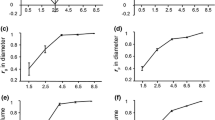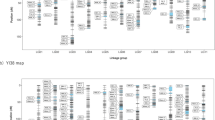Abstract
Regions of the genome affecting physical and chemical wood properties (quantitative trait loci (QTL)), as well as growth, were identified using a clonally replicated, outbred F2 family (112 genotypes, each with two ramets) of Eucalyptus globulus, planted in a field trial in north-west Tasmania. Traits studied were growth (assessed by stem diameter), wood density, cellulose content, pulp yield and lignin content. These traits are important in breeding for pulpwood, and will be important in breeding for carbon sequestration and biofuel production. Between one and four QTL were located for each trait, with each QTL explaining between 4% and 12% of the phenotypic variation. Several QTL for chemical wood properties were co-located, consistent with their high phenotypic correlations, and may reflect pleiotropic effects of the same genes. In contrast, QTL for density and lignin content with overlapping confidence intervals were considered to be due to independent genes, since the QTL effects were inherited from different parents. The inclusion of fully informative microsatellites on the linkage map allowed the determination of homology at the linkage group level between QTL and candidate genes in different pedigrees of E. globulus and different eucalypt species. None of the candidate genes mapped in comparable studies co-located with our major QTL for wood chemical properties, arguing that there are important candidate genes yet to be discovered.

Similar content being viewed by others
References
Apiolaza LA, Raymond CA, Yeo BJ (2005) Genetic variation of physical and chemical wood properties of Eucalyptus globulus. Silvae Genet 54:160–166
Beavis WD (1998) QTL analysis: power, precision, and accuracy. In: Patterson HA (ed) Molecular dissection of complex traits. CRC, Boca Raton, pp 145–162
Bradshaw HD, Foster GS (1992) Marker-aided selection and propogation systems in trees: advantages of cloning for studying quantitative inheritance. Can J Forest Res 22:1044–1049
Bradshaw HD, Stettler RF (1995) Molecular genetics of growth and development in Populus. IV. Mapping QTLs with large effects on growth, form, and phenology traits in a forest tree. Genetics 139:963–973
Brondani RPV, Brondani C, Grattapaglia D (2002) Towards a genus-wide reference linkage map for Eucalyptus based exclusively on highly informative microsatellite markers. Mol Genet Genomics 267:338–347
Brondani RPV, Williams ER, Brondani C, Grattapaglia D (2006) A microsatellite-based consensus linkage map for species of Eucalyptus and a novel set of 230 microsatellite markers for the genus. BMC Pant Biol 6:20
Bundock PC, Potts BM, Vaillancourt RE (2008) Detection and stability of quantitative trait loci (QTL) in Eucalyptus globulus. Tree Genet Genom 4:85–95
Churchill GA, Doerge RW (1994) Empirical threshold values for quantitative trait mapping. Genetics 138:963–971
Costa e Silva J, Borralho NMG, Araújo JA, Vaillancourt RE, Potts BM (2009) Genetic parameters for growth, wood density and pulp yield in Eucalyptus globulus. Tree Genet Genom 5:291–305
Cotterill P, Macrae S, Brolin A (1999) Growing eucalypt for high-quality papermaking fibres. Appita J 52:79–83
Devey ME, Carson SD, Nolan MF, Matheson AC, Te Riini C, Hohepa J (2004) QTL associations for density and diameter in Pinus radiata and the potential for marker aided selection. Theor Appl Genet 108:516–524
Doughty RW (2000) The Eucalyptus—a natural and commercial history of the gum tree. The Johns Hopkins University Press, Baltimore London
Downes G, Catela F, Meder R (2007) Developing and evaluating a global NIR calibration for the prediction of kraft pulp yield in eucalypts. In: Eucalypts and diversity: balancing productivity and sustainability, proceedings of IUFRO conference, 22–26 October 2007, Durban, South Africa
Dutkowski GW, Potts BM (1999) Geographic patterns of genetic variation in Eucalyptus globulus ssp. globulus and a revised racial classification. Aust J Bot 47:237–263
Falconer DS, Mackay TFC (1996) Introduction to quantitative genetics, 4th edn. Longman, Harlow Essex
Foucart C, Paux E, Ladouce N, San-Clemente H, Grima-Pettenati J, Sivadon P (2006) Transcript profiling of a xylem vs phloem cDNA subtractive library identifies new genes expressed during xylogenesis in Eucalyptus. New Phytol 170:739–752
Freeman JS, Potts BM, Shepherd M, Vaillancourt RE (2006) Parental and consensus linkage maps of Eucalyptus globulus using AFLP and microsatellite markers. Silvae Genet 44:202–217
Freeman JS, Potts BM, Vaillancourt RE (2008) Few mendelian genes underlie the quantitative response of a forest tree, Eucalyptus globulus, to a natural fungal epidemic. Genetics 178:563–571
Gilmour AR, Gogel BJ, Cullis BR, Thompson R (2006) ASReml user guide release 2.0. VSN International Ltd., Hemel Hempstead UK
Grattapaglia D, Kirst M (2008) Tansley review—eucalypt applied genomics: from gene sequences to breeding tools. New Phytol 179:911–929
Grattapaglia D, Bertolucci FL, Penchel R, Sederoff RR (1996) Genetic mapping of quantitative trait loci controlling growth and wood quality traits in Eucalyptus grandis using a maternal half-sib family and RAPD markers. Genetics 144:1205–1214
Hillis WE, Brown AG (1988) Eucalyptus for wood production. Academic CSIRO, Australia
Kirst M, Basten CJ, Myburg A, Zeng Z-B, Sederoff R (2005) Genetic architecture of transcript level variation in differentiating xylem of Eucalyptus hybrids. Genetics 169:2295–2303
MacDonald AC, Borralho NMG, Potts BM (1997) Genetic variation for growth and wood density in Eucalyptus globulus ssp. globulus in Tasmania. Silvae Genet 46:236–241
Markussen T, Fladung M, Achere V, Favre JM, Faivre-Rampant P, Aragones A, Perez Da Silva, Havengt L, Ritter E (2003) Identification of QTL controlling growth, chemical and physical wood property traits in Pinus pinaster (Ait). Silvae Genet 52:8–15
McRae TA, Pilbeam DJ, Powell MB, Dutkowski GW, Joyce K, Tier B (2004) Genetic evaluation in eucalypt breeding programs. In: Borralho NMG, Pereira JS, Marques C, Coutinho J, Madeira M, Tomé M (eds) Eucalyptus in a changing world proceedings of IUFRO Conference, 11–15 October Aveiro, Portugal. RAIZ, Instituto Investigação de Floresta e Papel pp 189–190
Milgate AW, Vaillancourt RE, Mohammed C, Powell M, Potts BM (2005) Genetic structure of a Mycosphaerella cryptica population. Australas Plant Path 34:45–354
Miranda I, Pereira H (2002) Variation of pulpwood quality with provenances and site in Eucalyptus globulus. Ann Forest Sci 59:283–291
Myburg AA, Potts BM, Marques CM, Kirst M, Gion J-M, Grattapaglia D, Grima-Pettenatti J (2007) Eucalypts. In: Kole C (ed) Genome mapping and molecular breeding in plants, vol 7. Springer, Berlin, pp 115–160
Núñez-Regueira L, Proupín-Castiñeiras J, Rodríguez-Añón JA (2002) Energy evaluation of forest residues originated from Eucalyptus globulus Labill in Galicia. Bioresource Tech 82:5–13
Poke FS, Raymond CA (2006) Predicting extractives, lignin, and cellulose contents using near infrared spectroscopy on solid wood in Eucalyptus globulus. J Wood Chem Technol 26:187–199
Poke FS, Wright JK, Raymond CA (2005) Predicting extractives and lignin contents in Eucalyptus globulus using near infrared reflectance analysis. J Wood Chem Technol 24:55–67
Poke FS, Potts BM, Vaillancourt RE, Raymond CA (2006) Genetic Parameters for lignin, extractives and decay in Eucalyptus globulus. Ann For Sci 63:813–821
Potts BM, Vaillancourt RE, Jordan GJ, Dutkowski GW, Costa e Silva J, McKinnon GE, Steane DA, Volker PW, Lopez GA, Apiolaza LA, Li Y, Marques C, Borralho NMG (2004) Exploration of the Eucalyptus globulus gene pool. In: Borralho NMG, Pereira JS, Marques C, Coutinho J, Madeira M, Tomé M (eds) Eucalyptus in a changing world proceedings of IUFRO Conference, 11–15 October Aveiro, Portugal. RAIZ, Instituto Investigação de Floresta e Papel, pp 46–61
Raymond CA (2002) Genetics of Eucalyptus wood properties. Ann For Sci 59:525–531
Raymond CA, Apiolaza LA (2004) Incorporating wood quality and deployment traits in Eucalyptus globulus and Eucalyptus nitens. In: Walter C, Carson M (eds) Plantation forest biotechnology for the 21st century. Research Signpost, Kerala, pp 87–99
Raymond CA, Schimleck LR (2002) Development of near infrared reflectance analysis calibrations for estimating genetic parameters for cellulose content in Eucalyptus globulus. Can J Forest Res 32:170–176
Rocha RB, Barros EG, Cruz CD, Rosada AM, Arouja EF (2007) Mapping of QTLs related with wood quality and developmental characteristics in hybrids (Eucalyptus grandis × Eucalyptus urophylla). Revista Árvore 31:13–24
Russell JH, Libby WJ (1986) Clonal testing efficiency: the trade-offs between clones tested and ramets per clone. Can J Forest Res 16:925–930
Sewell MM, Neale DB (2000) Mapping quantitative traits in forest trees. In: Jain SM, Minocha SC (eds) Molecular biology of woody plants vol 1. Kluwer Academic, The Netherlands, pp 407–423
Shepherd M, Cross M, Dieters MJ, Harding K, Kain D, Henry R (2003) Genetics of physical wood properties and early growth in a tropical pine hybrid. Can J Forest Res 33:1923–1932
Smook G (1992) Handbook for pulp and paper technologists. Angus Wilde, Vancouver British Columbia
Strauss SH, Lande R, Namkoong G (1992) Limitations of molecular-marker-aided selection in forest tree breeding. Can J Forest Res 22:050–1061
TAPPI (1989) Basic density and moisture content of pulp wood, TAPPI No. T258 om-98
Thamarus KA, Groom K, Bradley A, Raymond CA, Schimleck LR, Williams ER, Moran GF (2004) Identification of quantitative trait loci for wood and fibre properties in two full-sib pedigrees of Eucalyptus globulus. Theor Appl Genet 109:856–864
Thumma BR, Nolan MF, Evans R, Moran GF (2005) Polymorphisms in Cinnamoyl CoA Reductase (CCR) are associated with variation in microfibril angle in Eucalyptus spp. Genetics 171:1257–1265
Van Ooijen JW (1992) Accuracy of mapping quantitative trait loci autogamous species. Theor Appl Genet 84:803–811
Van Ooijen JW (1999) LOD significance thresholds for QTL analysis in experimental populations of diploid species. Heredity 83:613–624
Van Ooijen JW, Boer MP, Jansen C, Maliepaard C (2002) MapQTL® 4.0, software for the calculation of QTL position on genetic maps. Plant Research International, Wageningen
Verhaegen D, Plomion C, Gion JM, Poitel M, Costa P, Kremer A (1997) Quantitative trait dissection analysis in Eucalyptus using RAPD markers 1. Detection of QTL in hybrid progeny, stability of QTL expression across different ages. Theor Appl Genet 95:597–608
Volker PW, Potts BM, Borralho NMG (2008) Genetic parameters of intra- and inter-specific hybrids of Eucalyptus globulus and E. nitens. Tree Genet Genom 4:445–460
Wallis AFA, Wearne RH, Wright PJ (1996) Analytical characteristics of plantation eucalypt woods relating to kraft pulp yields. Appita J 49:427–432
Wei X, Borralho NMG (1997) Genetic control of wood density and bark thickness and their relationships with growth traits of Eucalyptus urophylla in South East China. Silvae Genet 46:245–250
Whittock SP, Dutkowski GW, Greaves BL, Apiolaza LA (2007) Integrating revenues from carbon sequestration into economic breeding objectives for Eucalyptus globulus pulpwood production. Ann For Sci 64:239–246
Wu HX (2002) Study of early selection in tree breeding 4. Efficiency of marker aided early selection (MAES). Silvae Genet 51:5–6
Zhang D, Zhang Z, Yang K (2006) QTL analysis of growth and wood chemical content traits in an interspecific backcross family of white poplar (Populus tomentosa × P. bolleana) × P. tomentosa. Can J Forest Res 36:2015–2023
Acknowledgements
This research was funded by Australian Research Council Linkage Grant (LP0453704) with industrial partners Gunns Ltd., the Forests and Forest Industries Council of Tasmania, the STBA, Forestry Tasmania, RAIZ, seedEnergy Pty. Ltd., Timbercorp Ltd. and WA Plantation Resources Ltd. We thank Kelsey Joyce and Gunns Ltd. for access to the trial site and help with clonal propagation, as well as Linda Ballard and Geoff Downes for NIR predictions and Paul Tilyard for data management.
Author information
Authors and Affiliations
Corresponding author
Additional information
Communicated by D. Grattapaglia
Rights and permissions
About this article
Cite this article
Freeman, J.S., Whittock, S.P., Potts, B.M. et al. QTL influencing growth and wood properties in Eucalyptus globulus . Tree Genetics & Genomes 5, 713–722 (2009). https://doi.org/10.1007/s11295-009-0222-0
Received:
Accepted:
Published:
Issue Date:
DOI: https://doi.org/10.1007/s11295-009-0222-0




